Jewel Orchid (Ludisia Discolor): Care and Growing Guide
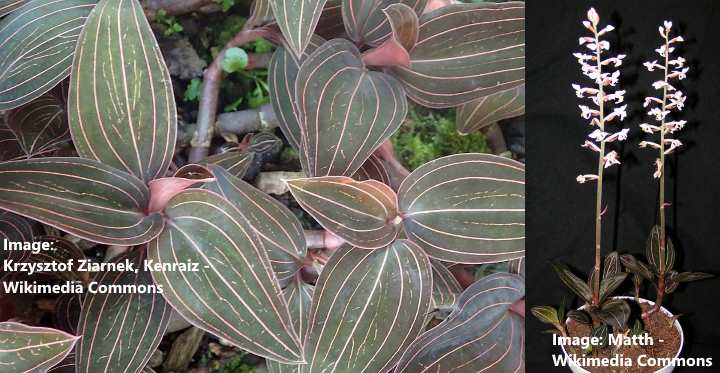
The Jewel Orchid (Ludisia discolor) is an unusual orchid species that grows spectacular dark, ovate-shaped leaves with pink veins. Jewel orchids bloom once a year, producing whitish flowers growing on long flower spikes. Unlike many orchid species, jewel orchids grow in the soil, prefer the shade, and are grown for their dark foliage rather than their exotic flowers.
The fascinating feature of the jewel orchid is its velvety leaves. The pointed lanceolate leaves have striking veins running from the base to the tip. The jewel orchid (Ludisia discolor) has smooth, broad, dark green, almost black leaves with pinkish-orange veins. The other species of jewel orchid (Ludisia discolor ‘Alba’) has vibrant green leaves with yellowish-white vein-like markings.
Although you can grow jewel orchids in the ground outdoors, they only grow in USDA zones 10 and 11. For most people, jewel orchids are easy-to-grow houseplants that are ideal for growing in indoor shaded areas. If you get the growing conditions right, a jewel orchid will thrive indoors for many years, giving plenty of visual interest with its large striking leaves.
This article is a complete guide to growing jewel orchids at home. You will also find out how to resolve some issues regarding caring for a jewel orchid.
How to Care for Jewel Orchid
To care for a jewel orchid, grow the orchid in an area away from direct sunlight. Ludisia orchids thrive growing in porous, well-draining potting soil. Water when the potting mix partially dries. Jewel orchid temperature range is 70°F to 80°F (21°C – 26°C) with at least 50 percent humidity. Fertilize every two to four weeks during summer.
What is Jewel Orchid?
Ludisia discolor is the only species in its genus and is commonly called the jewel orchid. This terrestrial orchid is a member of the orchid family Orchidaceae. However, there are a few jewel orchid cultivars, each with its own distinct leaf patterns and colors.
The jewel orchid is native to India, Southern China, and Southeast Asia. In its native habitat, Ludisia discolor grows in the ground in humid, tropical forests. Growing on the forest floor, jewel orchids survive well in low light conditions.
The jewel orchid (Ludisia discolor) is a type of terrestrial orchid. Unlike other orchid species, jewel orchids grow in soil rather than in an orchid bark potting mix. For example, popular orchids such as phalaenopsis orchids have aerial roots because they are epiphytic plants. Jewel orchids grow between 6” and 12” (15 – 30 cm) tall and 12 cm (30 cm) wide as a houseplant.
The term “jewel orchid” can also refer to other types of orchids grown for their foliage rather than flowers. For example, the Lighting Bolt jewel orchid (Macodes petola) has showy leaves with intricate web-like patterns.
Types of Jewel Orchid
Jewel orchid (Ludisia discolor)
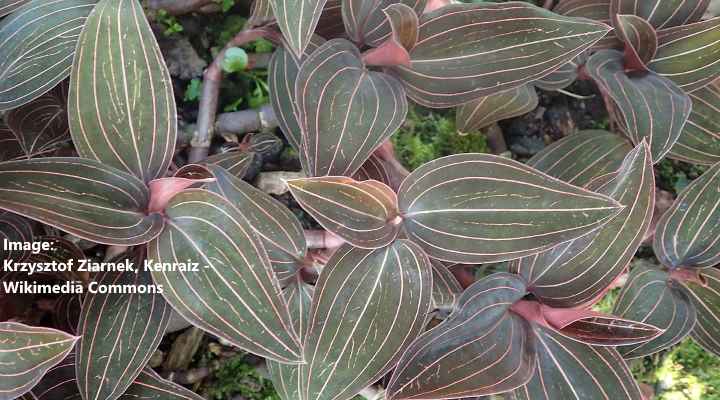
Ludisia discolor ‘Dawsoniana’
Jewel orchid is the species plant with deep green leaves and pink veins running through them. Like all jewel orchid cultivars, Ludisia discolor has whitish or creamy flowers blooming on the end of long erect stalks.
Black velvet jewel orchid (Ludisia discolor ‘Nigrescens’)
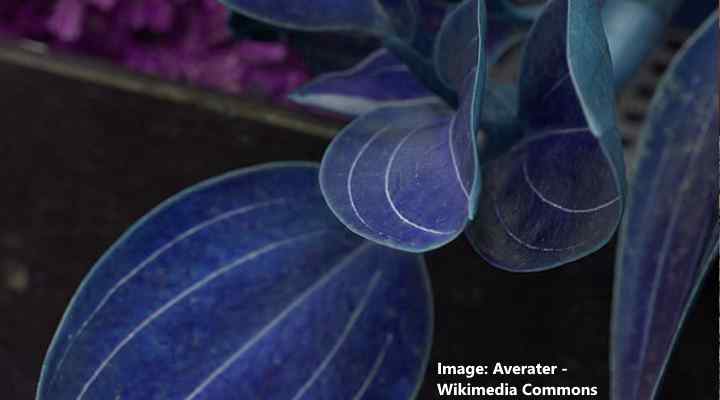
Ludisia discolor ‘Nigrescens’
The black velvet jewel orchid has stunning dark leaves that are almost black. The smooth foliage has pale lines running from the base to the tip.
Albino jewel orchid (Ludisia discolor ‘Alba’)
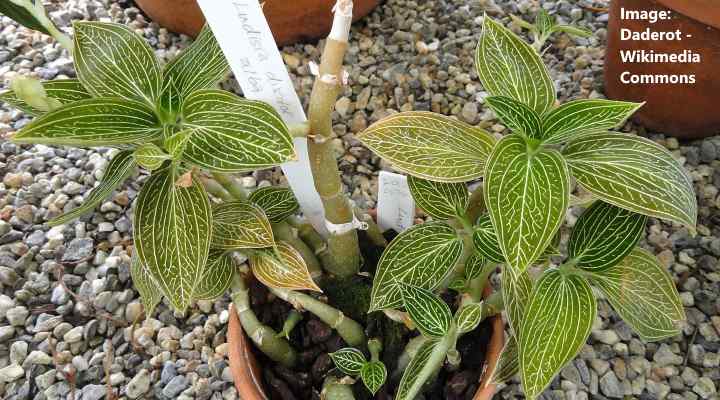
Ludisia discolor ‘Alba’
The jewel orchid cultivar ‘Alba’ has shiny green leaves with creamy-white veining.
Jewel Orchid Flowers
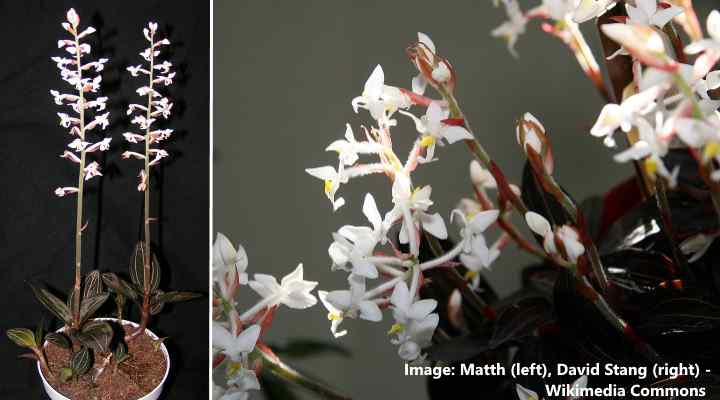
Jewel orchid flowers
Jewel orchid flowers are dainty flowers with small white petals and yellowish centers. The beautiful flowers bloom once a year and grow on the ends of tall flower spikes. Jewel orchids aren’t just foliage plants. If you care for jewel orchids properly, they will reward you with clusters of white flowers in winter.
Some plant owners decide to prune the flower stalks when they emerge. Because jewel orchids produce insignificant flowers, snipping off the flowering spike concentrates the plant’s energy in the roots and foliage. However, the flowers on jewel orchids are attractive enough to create interest while in bloom.
How to Get Jewel Orchid to Bloom
Proper care for jewel orchids encourages them to produce flowering spikes in fall. During the growing seasons, jewel orchids require reasonable levels of light and appropriate watering to grow healthy. Like other orchids, jewel orchids bloom when nighttime temperatures drop in the fall.
Jewel Orchid (Ludisia discolor) Care for Beginners
The jewel orchid is an easy-to-care-for orchid if you water it property and keep it in warm, humid conditions. You will have to ensure that this orchid species gets sufficient light—keeping out of direct sunlight but avoiding too much shade.
Let’s look in more detail at the best care tips for successfully growing a jewel orchid as a stunning houseplant.
Light Requirements for Growing Jewel Orchid Indoors
A jewel orchid grows best in medium light levels. If you’ve got a jewel orchid at home, the best care tip is to protect it from direct sunlight. A north-facing room is perfect for a jewel orchid. It would be best if you shielded the potted orchid from intense, direct sunshine in rooms facing east, west, or south.
Jewel orchids grow in shaded places in their natural environment. The plant rarely gets direct sunlight, so it’s vital to replicate these conditions at home.
You can tell if a jewel orchid gets too much light because its leaves will lose their vibrancy. Direct sunlight causes the leaf color to fade.
Jewel orchid is a fast-growing orchid in spring and summer if there’s enough light. However, a lack of bright light affects the orchid’s growth. You may notice that the plant doesn’t grow well during the growing season. Then, in the fall, the jewel orchid may fail to bloom if it didn’t get enough light during the year.
What Kind of Soil Does a Jewel Orchid Need?
The jewel orchid is a terrestrial orchid and grows in regular potting soil, not orchid potting bark. The best potting mix for Ludisia orchids is a mixture of two parts houseplant soil and one part perlite. Alternatively, you could grow a potted jewel orchid in an African violet mix.
When growing jewel orchids in pots, the goal is to create a potting medium that retains some moisture yet drains well. Typically, houseplant soil has a good mixture of organic matter, such as peat moss, that stays moist. Adding perlite makes the potting mix light and airy and helps to increase drainage.
You can add orchid bark to the jewel orchid’s soil. However, you should only add enough to help water to drain freely. Too many bark chips mean that the soil won’t retain enough moisture for healthy growth.
How to Water a Jewel Orchid
Water a jewel orchid as often as the top layer of soil dries out. Wait until the top 1” (2.5 cm) is dry before soaking the orchid’s potting soil. To care well for jewel orchids, always ensure the potting soil never dries out but is never soggy or too damp.
The best way to know when to water jewel orchids is to check the soil’s dryness. In summer, the orchid potting mix dries out faster, and you’ll need to water the orchid more frequently. In winter, when growth slows down, and temperatures are cooler, you should water less often. But remember that jewel orchids aren’t drought-tolerant plants.
It’s good to remember that factors such as climate, season, type of potting mix, and pot type all affect how quickly the orchid mix dries out.
One of the worst things you can do to a jewel orchid is let its roots sit in waterlogged soil. Excess dampness in the pot causes roots to rot quickly. If root damage isn’t too significant, the orchid may fail to flower in the fall. If root rot is extensive, the stems and beautiful foliage will become discolored, mushy, and the plant will eventually die.
Signs of under-watering jewel orchids include rapid flower drop, withered leaves, and slow growth.
Related reading: Top tips to water houseplants.
Temperature for Growing Ludisia discolor Indoors and Outdoors
Jewel orchids thrive indoors at average room temperatures. Keeping your room at an even temperature between 70°F and 80°F (21°C – 26°) is ideal for healthy jewel orchid growth. However, you’ll find that cooler temperatures between 60°F and 70°F (16°C – 21°C) will encourage blooming in fall and winter.
Ludisia discolor grows outdoors in USDA zones 10 through 12. The heat-loving orchid needs to grow in shaded yet humid environments. The absolute minimum temperature for jewel orchids is 50°F (10°C). Jewel orchids don’t tolerate frost.
You can grow a potted jewel orchid outdoors during summer if you live in temperate climates. Ensure that the nighttime temperature doesn’t drop below 60°F (16°C); otherwise, your tropical plant may suffer damage.
When growing jewel orchids indoors, make sure to protect them from sudden temperature fluctuations. Keep orchids away from cold drafts, air-conditioning vents, or hot air from heating vents.
Humidity Requirement for Growing a Jewel Orchid
Jewel orchids thrive in moderately humid conditions. Keep air moisture levels between 50 and 60 percent to encourage healthy jewel orchid growth. To boost humidity for your jewel orchid, you can stand the orchid pot on a half filled pebble tray or use a room humidifier.
Humidity is rarely an issue growing jewel orchids indoors if you water the tropical plants correctly. However, dry air in the winter months due to indoor heating can cause growth issues.
Here are four critical factors when caring for a jewel orchid indoors to prevent issues with humidity:
- Hydrate the potting mix properly
- Avoid direct sunlight
- Keep temperatures warm
- Ensure there’s adequate airflow.
These jewel orchid care tips can help you avoid any problems with air moisture levels.
How to Fertilize Jewel Orchid
A jewel orchid benefits from regular feeding during spring and summer. Use a balanced houseplant fertilizer or orchid feed and dilute it to half strength. It would be best if you held off fertilizing during winter when the plant’s growth slows down. However, you can fertilize jewel orchids in the fall to encourage blooming when the flower spikes emerge.
It’s best to reduce fertilizing frequency if you notice brown tips on leaves. Over-fertilization can sometimes cause the dark green leaves to develop brown patches.
Pruning a Jewel Orchid
Pruning a jewel orchid is rarely necessary. You can trim off emerging flower stalks if you’re not fussy about the orchid’s flowers. Otherwise, the only need to prune a jewel orchid is to divide the stems or roots if the plant is getting too big.
How to Propagate Ludisia discolor?
Jewel orchid propagation is straightforward through stem cuttings or root division. It’s easy to break off a piece of stem that has a few leaves on it. Alternatively, you can divide the jewel orchid’s root into two or three sections when repotting the plant.
To root the stems cuttings, place the end in some moist potting soil in a pot. Cover the pot with a plastic bag to seal in heat and moisture. Mist the soil every few days to keep the soil moist and boost humidity. It should take about two months for roots to appear.
Repotting a Jewel Orchid
Repotting a jewel orchid every year allows you to refresh the potting soil and give the orchid more room to grow. You should remove the orchid from its container, inspect the roots for damage, and divide the plant if necessary. Repot in a new container with an appropriate fresh potting soil.
A jewel orchid can quickly fill its pot, becoming overcrowded and stressed. Signs you need to repot a jewel orchid include leaf drop and roots poking out the soil’s surface.
Pests Affecting Jewel Orchid Growth
Mealybugs and scale insects are common houseplant pests that affect jewel orchids. Remove the plant-destroying bugs by dabbing them with rubbing alcohol to kill the pests on contact. Alternatively, use a natural neem oil pesticide to get rid of mealybugs and scale insects from orchids and other houseplants.
Mealybugs look like small fuzzy white insects on orchid stems and leaves. These destructive pests also leave behind a cotton wool-like substance on plant foliage. Like scale insects, mealybugs suck on plant sap, eventually destroying the orchid.
Related reading: How to make a DIY neem oil bug spray.
Diseases Affecting Jewel Orchid Growth
Plant diseases are uncommon on jewel orchids if you care for them properly. However, powdery mildew, root rot, and leaf spot can affect jewel orchids if there’s too much moisture in the soil or not enough air circulation. You may have to prune damaged foliage or change the potting mix to resolve these issues.
Related reading: How to get rid of powdery mildew.
Is a Jewel Orchid Toxic?
Jewel orchid is not poisonous to cats, dogs, or other pets. According to the ASPCA, Ludisia discolor (formerly Haemaria discolor) is a non-toxic type of orchid.
Jewel Orchid (Ludisia discolor) Care — FAQ
Although jewel orchids are easy houseplants, there are a few issues that can affect the orchid’s growth.
How do I get my jewel orchids to bloom more?
To get more flowers on a jewel orchid, you can apply fertilizer twice a week in early fall. A boost of nutrients encourages more flowers to emerge. After the buds appear, you should stop fertilizing during late fall and winter.
What does it mean when jewel orchid leaves curl?
Curling leaves on jewel orchids such as the Ludisia and Macodes species could indicate low humidity levels. Ensure that your orchid’s soil gets enough hydration to boost growth. If the leaves still curl, sit the orchid pot on a pebble tray with water to increase air humidity levels.
Why doesn’t my jewel orchid have any flowers?
Reasons for jewel orchids not producing flowers can be inadequate light or not enough water. To encourage healthy blooming, make sure the orchid grows in medium to bright light, protected from direct sunlight. It’s also necessary to water jewel orchids just enough to keep the soil moist.
What to do about yellowing Ludisia discolor leaves?
Jewel orchid leaves that turn yellow is usually a sign of overwatering. If you notice yellow lower leaves, hold off watering until the orchid soil partially dries. Then, keep your orchid watered just enough so the soil is slightly moist. Orchid roots that sit in waterlogged soil become diseased and turn leaves yellow.
Related articles:
